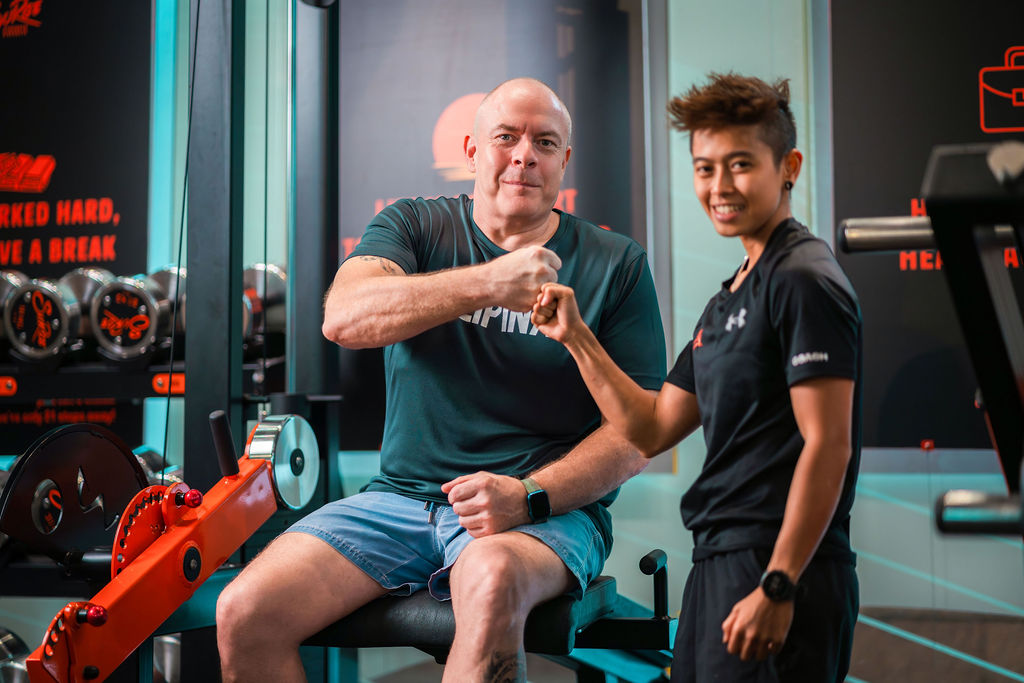
Eu Gene
July 30, 2024
Ern Ser
August 22, 2024Recovering completely after an injury can be challenging, be it a sports injury, a surgical procedure, or joint pain. When integrated carefully into your rehabilitation plan, personal training can play a crucial role in smoothing this journey and enhancing your overall recovery experience.
Personal training for injury rehab goes beyond traditional fitness routines by providing guidance that specifically addresses your unique needs and limitations during recovery. Unlike standard workout programs, personal training for injury rehabilitation focuses on rebuilding strength, improving mobility, and ensuring safe progression to prevent re-injury.
In this blog post, we’ll explore how personal trainers can help you recover more effectively and safely.

Understanding Rehabilitation
Injury rehabilitation is a comprehensive process designed to restore both form and function following an injury. It focuses on healing damaged tissues and improving strength, and overall physical performance. The rehabilitation process generally has five key stages:
- Injury or condition identification
- Acute stage
- Subacute stage
- Late subacute stage
- Return to function
Each stage addresses distinct goals, including managing pain, restoring range of motion, enhancing strength and stability, retraining functional movements, and transitioning back to regular activities. Injuries vary widely in type and severity, meaning that a one-size-fits-all approach is rarely effective. Rehabilitation programs must be tailored to the individual’s specific needs, addressing the unique aspects of their injury and overall physical condition.
Personal trainers for injury recovery play a pivotal role in this process, particularly after the initial phase of physical therapy. Their guidance ensures that exercises are performed correctly, reducing the risk of re-injury. They also educate individuals on injury prevention strategies, such as proper warm-ups, cool-downs, and technique adjustments.
Personal Training for Patient Rehabilitation
Here’s how personal training can effectively contribute to patient rehabilitation:
Targeted Strength Building
Injuries often lead to muscle weakness and imbalances. Personal trainers focus on rebuilding strength in the affected area through targeted exercises. They use a variety of techniques for strength training recovery to help you regain muscle mass and function, improving your overall physical capability and supporting the healing process, further enhancing your ability to return to daily activities and previous fitness levels.
Pain and Inflammation Management
Your personal trainer will guide you through activities and exercises to improve circulation, which helps reduce swelling and promotes healing. For example
- Gentle aerobic exercises and specific movements enhance blood flow to affected areas.
- Strengthening exercises stabilize the injured area, reducing stress and supporting recovery
- Low-impact activities like swimming or cycling also help minimize joint stress and prevent aggravation of inflammation.
Trainers emphasize proper form to ensure exercises are performed safely, avoiding further strain.
Enhancing Mental and Emotional Well-being
Personal trainers offer essential support and encouragement to help you stay motivated throughout your recovery journey. Trainers work with patients to set realistic and achievable goals, breaking down the recovery process into manageable steps. This structured approach not only gives them a sense of accomplishment but also helps patients maintain focus and motivation. Regular feedback and encouragement from trainers contribute to a positive mindset, reducing feelings of discouragement or anxiety.
Preventing Reinjury
Personal trainers ensure that strength training after injury and all the other exercises are performed with proper form and technique, which is crucial for avoiding compensatory movements that could lead to new injuries. They provide detailed instructions on exercise execution, helping you build strength and stability in a controlled manner that reduces the likelihood of setbacks.
Ongoing Monitoring and Adjustments
As you progress through your rehabilitation, they continuously monitor your performance and adjust your exercise program as needed. They assess your improvements, identify any new challenges, and modify your plan to keep you on track. Based on these assessments, trainers modify your exercise plan to address evolving needs and prevent plateaus. With this adaptive approach, they ensure your rehabilitation stays aligned with your recovery goals and maintains its effectiveness

Restoring Range of Motion
Joint stiffness is common following an injury. In your functional training for an injury recovery program, your trainer will develop exercises that specifically target the injured area to improve the range of motion. Through gentle stretching and mobility exercises, they help restore joint function and alleviate discomfort, allowing you to move more freely and comfortably.
Specialized Support for Athletic Injury Rehabilitation
For those specifically focused on recovery from sports injuries, personal trainers offer tailored programs that address the unique demands of athletic rehabilitation, ensuring a safe and effective return to sports activities.
Conclusion
For those looking to integrate personal training into their rehabilitation and are finding a rehab personal trainer, Surge: Strength & Results offers a range of services to meet your needs. From strength training and nutrition guidance to finding a certified personal trainer, we are dedicated to supporting your recovery and enhancing your overall well-being.
Embrace the support of a personal trainer and take a proactive approach to your rehabilitation. With our expertise, you can confidently navigate the path to recovery and emerge stronger than ever.
































